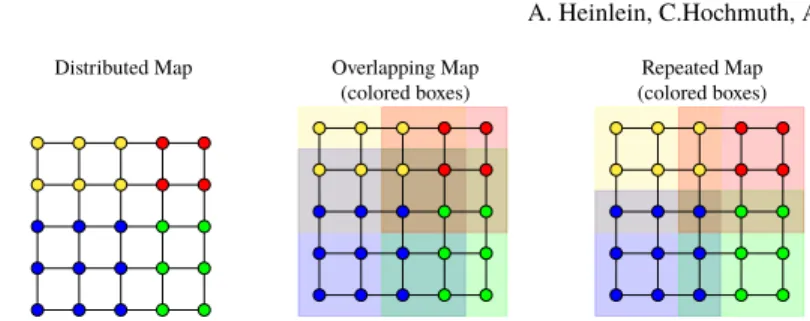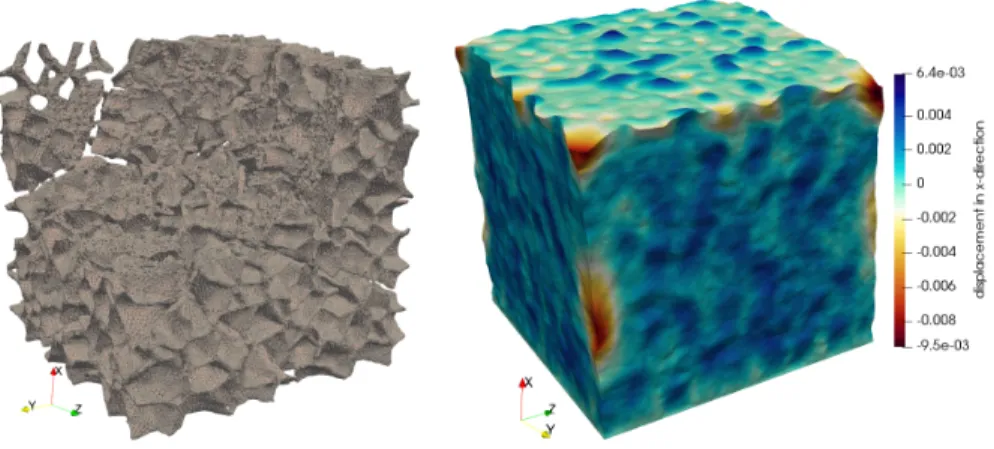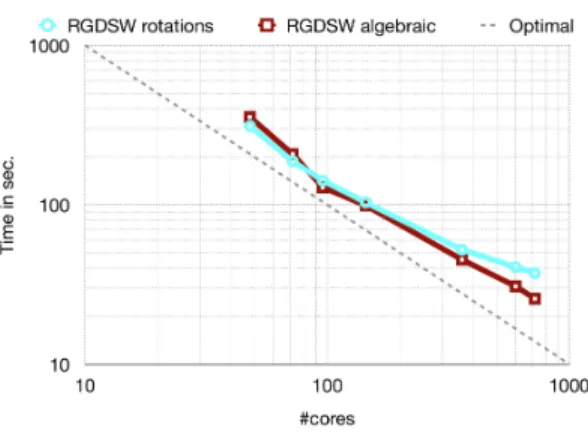Technical Report Series
Center for Data and Simulation Science
Alexander Heinlein, Christian Hochmuth, Axel Klawonn
Fully algebraic two-level overlapping Schwarz preconditioners for elasticity problems
Technical Report ID: CDS-2019-21
Available at https://kups.ub.uni-koeln.de/id/eprint/10441
Submitted on December 16, 2019
Fully algebraic two-level overlapping Schwarz preconditioners for elasticity problems
Alexander Heinlein
1,2, Christian Hochmuth
1, and Axel Klawonn
1,21 Introduction
We consider the solution of large, parallel distributed stationary and dynamic dis- cretized elasticity problems with a moderate Poisson ratio; i.e., we do not consider the nearly incompressible case. As the solver, we use the Generalized Minimal Residual (GMRES) method preconditioned by two-level overlapping Schwarz precondition- ers with Generalized Dryja–Smith–Widlund (GDSW) [2, 3] and Reduced dimension GDSW (RGDSW) [5, 12] coarse spaces. Even though these preconditioners can be constructed from the fully assembled system matrix, a minimum of geometric in- formation is also needed. In particular, the domain decomposition interface and the null space are used for their construction. Here, we focus on the construction of fully algebraic GDSW type coarse spaces if this information is not available. In particular, we consider the case when the system matrix is uniquely distributed, such that the interface cannot be identified.
Therefore, we will describe a method to approximate the nonoverlapping subdo- mains, resulting in an approximate interface; cf. [10]. Our parallel implementation is based on the
FROSchframework [9], which is part of the
ShyLUpackage in Trilinos [13]; see [11, 10] for more details on the implementation. To discuss the performance of the fully algebraic approach, we will compare it to the classical GDSW type coarse spaces using all necessary information.
1Department of Mathematics and Computer Science, University of Cologne, Weyertal 86-90, 50931 Köln, Germany
2Center for Data and Simulation Science, University of Cologne, Germany, url:http://www.cds.uni-koeln.de
1
2 A. Heinlein, C.Hochmuth, A.Klawonn
2 Model Problems
The equilibrium equation for an elastic body covering the domain
Ω=[0,1]3under the action of a body force
fin the time interval
[0,T]is
∂ttu−
div
σ= fin
Ω× [0,T],(1)
with the symmetric Cauchy stress tensor
σand the displacement
u. We consider aSaint Venant-Kirchhoff material, a hyperelastic material with the linear material law
σ(E)=λ
2
(trace E)
2+µtrace EI (2)
and the nonlinear strain tensor given by E :=
12(C−I),where C is the right Cauchy- Green tensor. Furthermore, we consider the boundary conditions
u
=0 on
∂ΩD:=
{0
} × [0, 1
]2, σ·n
=0 on
∂ΩN:=
∂Ω\∂ΩD,and the body force
f =(−20,0, 0)
T, for
t<5
·10
−3, and
f =0, afterwards.
In addition to this, we also consider a stationary problem with
∂ttu=0, i.e., div
σ=(0,
−100, 0
)Tin
Ω,u
=0 on
∂ΩD:=
{0
} × [0, 1
]2, σ·n
=0 on
∂ΩN:=
∂Ω\∂ΩD.(3)
We transform the model problems to their respective variational formulations and discretize them using piecewise linear or quadratic finite elements; we denote the corresponding finite element spaces by
Vh =Vh(Ω). For the time-dependent prob- lem, the resulting semi-discrete problem is further discretized with the Newmark–β method. In particular, we choose the parameters for the fully implicit constant average acceleration method, i.e.,
β=1
/2 and
γ=1
/4.
The fully discrete nonlinear equations are linearized using Newton’s method. We solve the equation
J(u(k))δu(k+1)=R(u(k)),
(4)
for the update
δu(k+1). Here,
J(u(k))and
R(u(k))are the Jacobian and the nonlinear residual for the solution
u(k), respectively.
2.1 GDSW and RGDSW Preconditioners
We consider the system of linear equations (4) as derived in the previous section.
For simplicity, we use the notation
Ax=bin this section.
Let
Ωbe decomposed into nonoverlapping subdomains
{Ωi}i=1Nwith typical diameter
Hand corresponding overlapping subdomains
Ωi0 Ni=1
, resulting from extending the nonoverlapping subdomains by
klayers of elements. We define
Ri:
Vh → Vih,
i =1, . . . ,
N, as the restriction from the global finite element space
Vhto the local finite element space
Vih:=
Vh Ω0i
and corresponding prolongation operators
RTi. In addition to that, we can also define restricted and scaled prolongation operators ˜
RTi; cf., e.g., [1, 4, 7].
Furthermore, let
Γ:=
nx∈ (Ωi∩Ωj) \∂ΩD
:
i,j,1≤i,j ≤N obe the interface of the nonoverlapping domain decomposition.
The GDSW preconditioner, which was introduced by Dohrmann, Klawonn, and Widlund in [2, 3], is a two-level additive overlapping Schwarz preconditioner with energy minimizing coarse space and exact solvers. Thus, the preconditioner can be written in the form
MGDSW−1 =ΦA−01ΦT+ ÕN
i=1
RTi A−i1Ri,
(5) where
Ai = RiARTi. In the second level, we solve the coarse problem matrix
A0 = ΦTAΦ. The columns of
Φare the basis functions of the coarse space. To construct the GDSW coarse basis functions, let
RΓjbe the restriction from
Γonto the interface component
Γj. For the GDSW coarse space in three dimensions, the in- terface components are the vertices, edges, and faces. Then, the values of the GDSW basis functions on
Γread
ΦΓ= RTΓ
1ΦΓ1 ...RTΓ
MΦΓM,
where the columns of
ΦΓjare the restrictions of the null space of subdomain Neu- mann matrices to the interface component
Γj. For elasticity, the null space consists of the rigid body motions, i.e., the translations and rotations. After partitioning the degrees of freedom into interface (Γ) and interior (I) ones, the matrix
Acan be written as
A=
AI I AIΓ
AΓI AΓΓ
and the GDSW coarse basis functions are the discrete harmonic extensions of
ΦΓinto the interior,
Φ= ΦI
ΦΓ
=
−A−1I IAIΓΦΓ ΦΓ
.
(6)
The RGDSW coarse space is constructed similarly. However, in general, we only
obtain one basis function for each vertex, resulting in a much smaller dimension
of the coarse space; cf. [5] and, for more details on the parallel implementation in
4 A. Heinlein, C.Hochmuth, A.Klawonn
Distributed Map Overlapping Map Repeated Map
(colored boxes) (colored boxes)
Fig. 1 Sketch of the approximation of the nonoverlapping subdomains and the interface, respec- tively: uniquely distributed map (left); extension of the uniquely distributed map by one layer of elements resulting in an overlapping map, where the overlap contains the interface (middle); by se- lection, using the lower subdomain ID, the a map approximating to the nonoverlapping subdomains is constructed (right). Taken from [10].
FROSch, [12, 7]. The reduction of the coarse space dimension can also be seen in Table 1. There are several variants of RGDSW coarse spaces, which differ in a scaling of the interface degrees of freedom. Here, we will only consider the most algebraic variant, which is denoted as Option 1 in [5]; cf. [7] for a detailed description of our implementation of Option 1 of the RGDSW coarse space.
In our numerical simulations, we will also employ the recycling strategies pre- sented in [7]. We always reuse the symbolic factorizations from previous time or Newton iterations. Moreover, we reuse the coarse space from previous iterations and, for the dynamic problem, additionally the coarse matrix. Furthermore, as in [7], we always use a scaled first level operator with overlap
δ=1h.
3 Fully Algebraic Construction of GDSW and RGDSW Coarse Spaces
As previously described, the construction of GDSW and RGDSW coarse spaces for elasticity problems requires both the domain decomposition interface and the null space of the operator, i.e., the rigid body motions. Here, we describe how we construct the coarse space if this information is not available.
Algebraic approximation of the interface If the distribution of the system ma-
trix is unique, the interface cannot be recovered. Therefore, we will carry out the
following process to approximate the nonoverlapping subdomains and hence the
interface. Starting from the unique distribution, we first add one layer of elements to
each subdomain. The overlap of the resulting domain decomposition now contains
the interface but also other finite element nodes. In order to reduce the number of
unnecessary nodes, we compare the subdomain ID of the original unique decom-
position and the decomposition with one layer of overlap and remove nodes from
the overlapping subdomains if the subdomain ID is lower compared to the original
decomposition; this process is sketched in [10] and Figure 1.
Fig. 2 Left: Slice through elements with high coefficient (µhigh =103) displayed as a wireframe.
Low coefficient isµlow= 1; cf. [8], for a detailed discussion of the foam geometry used for an heterogeneous Poisson problem. Right: Solution of dynamic problem atT =10−2for∆t=10−3 with a warp filter and a 5 times scaling factor.
Incomplete null space The rigid body modes are the translations and rotations of the elastic body. The translations are constant functions which can be constructed without any geometric information. Since we are not able to compute the rotations from the fully assembled matrix and without coordinates of the finite element nodes, we just omit them in the fully algebraic coarse space; see also [11]. For the results in section 4, only the number of iterations is negatively effected by omitting rotations from the coarse space but the time to solution actually benefits from the smaller coarse space. Note that, from theory, the rotational basis functions are necessary for numerical scalability. Therefore, we expect that there are problems for which the full coarse space performs better.
4 Numerical Results
In this section, we compare the GDSW and RDSW preconditioners with exact
interface maps and full coarse space, GDSW and RGDSW preconditioners with exact
interface map but without rotational basis functions, and the fully algebraic variant
with approximated interface and without rotational basis functions; for the sake of
brevity, we denote the three variants as “rotations”, “no rotations”, and “algebraic”,
respectively. As discussed in section 2, we consider a stationary elasticity problem
with homogeneous shear modulus of
µ=5
·10
3and a dynamic elasticity problem
with two material phases; cf. Figure 2 (left) for a graphical representation of the
coefficient distribution of the shear modulus. For both cases, we choose
ν=0.4. For
the stationary homogeneous model problem, we use structured grids and structured
decompositions into square subdomains, whereas for the dynamic problem, we use
6 A. Heinlein, C.Hochmuth, A.Klawonn
Fig. 3 Strong scaling for dynamic problem up to timeT=2·10−2for the foam geometry.
#cores 64 512 4 096
GDSW
rotations 1 593 16 149 144 045 no rotations 837 8 589 77 085 algebraic P1 disc. 1 395 11 355 84 762 algebraic P2 disc. 1 554 11 466 84 708 RGDSW
rotations 162 2 058 20 250 no rotations 81 1 029 10 125 algebraic P1 disc. 93 1 065 10 218 algebraic P2 disc. 93 1 038 10 134
Table 1 Comparison of coarse matrix sizes for a structured domain decomposition and the approx- imated subdomain maps for a P1 (H/h=21) and P2 (H/h=9) discretizaion.
a fixed unstructured tetrahedral mesh with roughly 3.3 million elements and 588 k nodes. We use the inexact Newton method of Eisenstat and Walker [6] with a type 2 forcing term until a relative residual of
nl=10
−8is achieved. The initial forcing term is
ηinit=10
−3and the maximum and minimum forcing terms are
ηmax=10
−2and
ηmin=10
−8, respectively. Therefore, we use a combination of the Trilinos packages
Thyraand
NOX. Furthermore,NOXis used for a backtracking globalization strategy. In particular, the step length is chosen as 0.5
lwith
l =0, 1, ... until the Armijo condition is satisfied. All linearized problems are solved with right-preconditioned GMRES with the corresponding GDSW and RGDSW preconditioners and the tolerance for the relative residual error is the forcing term
η. All computations were carried outon the supercomputer magnitUDE of the University Duisburg-Essen, Germany.
In Tables 2 and 3, weak scaling results for the stationary model problem with
piecewise linear and piecewise quadratic elements are depicted. Although, iteration
counts are slightly higher for the RGDSW coarse spaces compared to the respective
GDSW coarse spaces, the total computation time is much smaller for RGDSW due
to the lower dimension of the coarse problem. This effect is even stronger for larger
numbers of subdomains and cores; cf. Table 1. Furthermore, we observe competitive
Prec. Type #cores 64 512 4 096
GDSW
rot. #its. 17.8 19.0 19.0
time 35.1 / 7.4 / 42.5 45.3 / 9.7 / 55.0 167.1 / 26.1 / 183.2
no rot. #its. 27.3 32.0 35.5
time 29.3 / 10.6 / 39.9 32.9 / 13.8 / 46.7 70.8 / 23.3 / 94.1
algebraic #its. 32.8 38.5 39.0
time 39.5 / 13.4 / 52.9 41.6 / 17.2 / 58.8 84.3 / 27.3 / 111.6
RGDSW
rot. #its. 20.5 22.5 22.5
time 28.8 / 8.2 / 37.0 30.9 / 9.5 / 40.4 42.0 / 11.7 / 53.7
no rot. #its. 33.0 37.3 39.5
time 25.2 / 12.4 / 37.6 26.5 / 14.7 / 41.2 30.1 / 18.0 / 48.1
algebraic #its. 40.0 42.0 43.0
time 27.2 / 15.5 / 42.7 28.7 / 16.8 / 45.5 32.9 / 19.6 / 52.5
Table 2 Stationary problem, discretization P1 (H/h=21), iteration counts are averages over all Newton iterations. All problems were solved in 4 Newton iterations. The three timings are for the setup / solve / total time and are in seconds. All total times are highlighted.Prec. Type #cores 64 512 4 096
GDSW
rot. #its. 16.3 17.3 19.3
time 40.1 / 5.9 / 46.0 55.0 / 8.5 / 63.5 223.3 / 24.4 / 247.7
no rot. #its. 24.5 29.3 32.3
time 32.5 / 8.4 / 40.9 38.4 / 11.8 / 46.7 102.2 / 20.0 / 122.2
algebraic #its. 57.5 74.8 78.0
time 42.0 / 20.5 / 62.5 46.0 / 29.9 / 75.9 124.8 / 50.5 / 175.3
RGDSW
rot. #its. 18.8 21.3 19.8
time 27.8 / 6.4 / 34.2 31.1 / 8.0 / 39.1 41.3 / 8.9 / 50.2
no rot. #its. 29.0 32.8 35.5
time 26.2 / 9.4 / 35.6 27.3 / 11.8 / 39.1 31.1 / 14.3 / 45.4
algebraic #its. 60.7 78.5 83.0
time 27.9 / 19.9 / 47.8 28.7 / 27.9 / 56.6 34.1 / 33.1 / 67.2
Table 3 Stationary problem, discretization P2 (H/h =9), iteration counts are averages over all Newton iterations. All problems were solved in 4 Newton iterations. The three timings are for the setup / solve / total time and are in seconds. All total times are highlighted.iteration counts and computing times when using the fully algebraic coarse spaces.
In addition to that, the approximation strategy for the interface seems to perform better for piecewise linear than for piecewise quadratic elements.
In Figure 3, we present strong scaling results from 48 to 720 cores for the dynamic model problem. The reported times are the total times for our preconditioners, i.e., the sum of the times needed for their construction and their applications in GMRES.
We solve the problem with
∆t =10
−3up to a final time
T =2
·10
−2using the
RGDSW rotations coarse space and using the RGDSW algebraic coarse space both
with matrix recycling; cf. [7]. Here, we observe very good strong scalability results
8 A. Heinlein, C.Hochmuth, A.Klawonn
for both variants even though the model problem has coefficient jumps. Again, the fully algebraic variant is competitive.
AcknowledgementsThe authors gratefully acknowledge financial support by the German Science Foundation (DFG), project no. 214421492 and the computing time granted by the Center for Computational Sciences and Simulation (CCSS) of the University of Duisburg-Essen and provided on the supercomputer magnitUDE (DFG grants INST 20876/209-1 FUGG, INST 20876/243-1 FUGG) at the Zentrum für Informations- und Mediendienste (ZIM). We further thank Jascha Knepper for providing the foam geometry.
References
1. X.-C. Cai and M. Sarkis. A restricted additive Schwarz preconditioner for general sparse linear systems.SIAM Journal on Scientific Computing, 21:239–247, 1999.
2. C. R. Dohrmann, A. Klawonn, and O. B. Widlund. Domain decomposition for less regular subdomains: overlapping Schwarz in two dimensions.SIAM J. Numer. Anal., 46(4):2153–2168, 2008.
3. C. R. Dohrmann, A. Klawonn, and O. B. Widlund. A family of energy minimizing coarse spaces for overlapping Schwarz preconditioners. InDomain decomposition methods in science and engineering XVII, volume 60 ofLect. Notes Comput. Sci. Eng., pages 247–254. Springer, Berlin, 2008.
4. C. R. Dohrmann and O. B. Widlund. Hybrid domain decomposition algorithms for compress- ible and almost incompressible elasticity. Internat. J. Numer. Meth. Engng, 82(2):157–183, 2010.
5. C. R. Dohrmann and O. B. Widlund. On the design of small coarse spaces for domain decomposition algorithms.SIAM J. Sci. Comput., 39(4):A1466–A1488, 2017.
6. S. C. Eisenstat and H. F. Walker. Choosing the forcing terms in an inexact Newton method.
volume 17, pages 16–32. 1996. Special issue on iterative methods in numerical linear algebra (Breckenridge, CO, 1994).
7. A. Heinlein, C. Hochmuth, and A. Klawonn. Reduced dimension GDSW coarse spaces for monolithic Schwarz domain decomposition methods for incompressible fluid flow problems.
International Journal for Numerical Methods in Engineering, n/a(n/a).
8. A. Heinlein, A. Klawonn, J. Knepper, and O. Rheinbach. Adaptive GDSW coarse spaces for overlapping Schwarz methods in three dimensions. SIAM Journal on Scientific Computing, 41(5):A3045–A3072, 2019.
9. A. Heinlein, A. Klawonn, S. Rajamanickam, and O. Rheinbach. FROSch – a parallel imple- mentation of the GDSW domain decomposition preconditioner in Trilinos. In preparation.
10. A. Heinlein, A. Klawonn, S. Rajamanickam, and O. Rheinbach. FROSch: A Fast and Robust Overlapping Schwarz Domain Decomposition Preconditioner Based on Xpetra in Trilinos.
Technical report, Universität zu Köln, November 2018.
11. A. Heinlein, A. Klawonn, and O. Rheinbach. A parallel implementation of a two-level over- lapping Schwarz method with energy-minimizing coarse space based on Trilinos.SIAM J. Sci.
Comput., 38(6):C713–C747, 2016.
12. A. Heinlein, A. Klawonn, O. Rheinbach, and O. B. Widlund. Improving the parallel perfor- mance of overlapping Schwarz methods by using a smaller energy minimizing coarse space.
International Conference on Domain Decomposition Methods, pages 383–392. Springer, 2017.
13. M. A. Heroux, R. A. Bartlett, V. E. Howle, R. J. Hoekstra, J. J. Hu, T. G. Kolda, R. B. Lehoucq, K. R. Long, R. P. Pawlowski, E. T. Phipps, A. G. Salinger, H. K. Thornquist, R. S. Tuminaro, J. M. Willenbring, A. Williams, and K. S. Stanley. An overview of the Trilinos project.ACM Trans. Math. Softw., 31(3):397–423, 2005.


